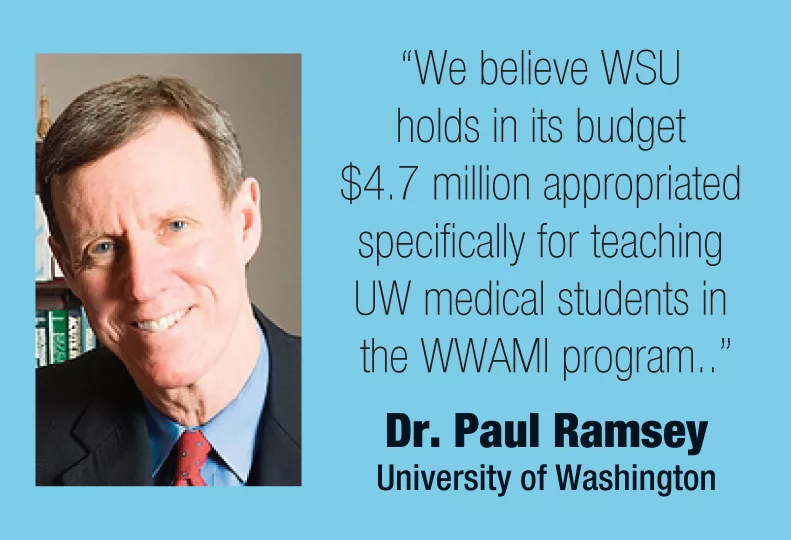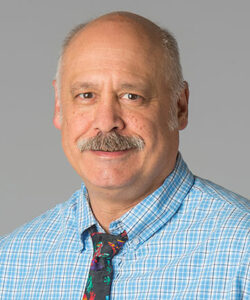UW says WWAMI program growth is in jeopardy
Senate budget proposal amounts to funding cut

The Washington state Senate budget proposal would put the Spokane-based portion of the five-state medical education program known as WWAMI in peril if it wins out over the House version of the budget, says Dr. Paul Ramsey, the CEO of University of Washington Medicine.
Washington State University, meantime, prefers the Senate budget proposal in regard to medical education in Spokane, WSU President Elson Floyd recently indicated in a letter to the UW administration.
The Senate Republicans’ budget proposes to allocate $2.5 million to UW for the WWAMI program for the 2015-2017 biennium, far below UW’s request for $8 million to expand the program.
Ramsey says, “Our goal is to achieve funding to not only continue WWAMI, but expand it and improve its quality.”
The Senate proposal, however, wouldn’t provide enough funds to continue the WWAMI program without cutting it back after the upcoming 2015-2016 academic year, Ramsey contends.
The House Democrats’ version of the budget would provide a WWAMI funding level of $9.4 million for the biennium, by transferring funds to UW from WSU.
Both budget proposals would allocate $2.5 million to WSU to begin the accreditation process for an independent medical school to be based in Spokane.
Negotiations over the overall state operating budget had stalled in the Legislature as of earlier this week, and the regular legislative session is scheduled to end Sunday.
WWAMI, which stands for Washington, Wyoming, Alaska, Montana, and Idaho, is a UW School of Medicine program that teaches first- and second-year medical students representing the five states.
The program for the 2015-2016 academic year, which begins in August, is expected to have 40 first-year students, and 15-second year students in Spokane.
The House version of the budget would enable UW to expand the WWAMI program to up to 60 students in each year class, starting in the 2016-2017 academic year, Ramsey says.
WSU’s longstanding partnership with UW in the WWAMI program is splitting up over WSU’s plans to develop its own fully accredited medical school to be based on the Riverpoint Campus.
“We will be looking for another WWAMI partner in Spokane,” Ramsey says.
UW’s first task regarding WWAMI, however, is to secure legislative funding for it, he says.
Ramsey asserts the Senate version of the budget leaves WSU with funds that originally were intended to benefit the WWAMI program.
“We believe WSU holds in its (annual)budget $4.7 million appropriated specifically for teaching UW medical students in the WWAMI program,” he says.
He says UW unsuccessfully attempted to negotiate with WSU for those funds, which the House budget proposal would return to UW.
“We will advocate for that budget,” Ramsey says. “If those funds are returned, we will be expanding the class sizes. If they’re not returned, we won’t be able to meet that commitment.”
UW would seek further funding in future budgets with the eventual goal to expand medical student numbers to 120 students per year, Ramsey says.
While WSU contends a second medical school in Washington state will help address a widespread physician shortage in the state outside of the Puget Sound area, UW’s Ramsey says it will be a number of years before WSU is able to produce its first class of physicians, because WSU still has to go through the accreditation process.
“Then there’s the question of legislative funding,” Ramsey says, adding that a startup medical school would require more funding than the expanded WWAMI program.
Ramsey asserts WSU’s medical program will cost the state more than $30,000 more per student per year than the WWAMI program.
“WWAMI is much more cost effective and a proven program,” he asserts.
For now, WSU prefers the Senate budget proposal, according to a recent letter WSU president Floyd sent to UW acting President Ana Mari Cauce.
“We are of course led to this position by our collective inability to achieve a resolution on the operating funds associated with WSU’s participation in the WWAMI program,” Floyd says in the letter.
He also says medical education funding allocated to WSU isn’t earmarked solely for the WWAMI program, although WSU has been responsible for instructing first-year students in the program.
“As you have rejected our … offer reflecting funding that serves (first-year WWAMI) students, and we have rejected a transfer that would defund WSU instruction of non-WWAMI health sciences students and biomedical research on the Spokane campus, we are left to await the resolution in the operating budget currently being negotiated in the Legislature,” Floyd says in the letter.
Floyd also indicates in the letter that WSU is amenable to rethinking the WWAMI breakup.
“While we acknowledge that our WWAMI partnership is scheduled to end June 30, 2015, we reiterate our continued willingness to revisit that topic. We continue to believe maintaining this partnership in some form to be the most efficient use of existing resources to serve existing students,” he says.
Like Floyd, Ken Roberts, acting dean for WSU Medical Sciences, says medical education funding allocated to WSU isn’t meant just for the WWAMI program.
“A portion goes to teaching medical students,” he says. “The (WSU) faculty that has taught WWAMI does other things, including research.”
Roberts claims WSU’s community-based medical education model is cost effective.
“With our infrastructure and the faculty we’ve hired, we can deliver medical education in the same cost-effective range as UW,” he contends. “We’ve been doing that as a WWAMI partner for quite some time.”
Roberts notes that both WSU and UW have drawn from findings of the 2010 Tripp Umbach study, which recently was updated. Both schools have cited estimates that a Spokane-based medical program could generate 9,000 jobs and have an economic impact of $1.6 billion in the Spokane community by 2030.
Roberts asserts, though, that a key premise for the projected economic impact is that medical education would be expanded here to include a full four-year medical school with faculty that conducts research and produces physicians. The WWAMI program alone can’t deliver all of that, he says.
“WWAMI is primarily an educational program. It doesn’t actually put a medical school in the region,” Roberts says.
Despite the WWAMI breakup, WSU Spokane has the capacity to continue to host the WWAMI program in its Biomedical Sciences building and other facilities on the Riverpoint Campus.
“We’re prepared to support the WWAMI program as we start our own medical school here,” Roberts says. “I don’t think it would be a problem for both programs to be here.”
He notes, however, that if UW were to build WWAMI up to 120 medical students per year, that would be higher than the number of students the UW School of Medicine currently has per year in Seattle.
Related Articles
Related Products


_c.webp?t=1763626051)
_web.webp?t=1764835652)

